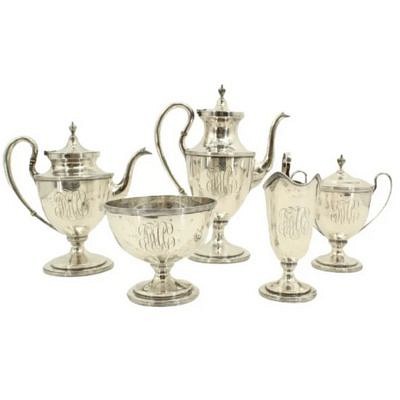Poems By Lydia H. Sigourney 1841
About Seller
522 South Pineapple Avenue
Sarasota, FL 34236
United States
Sarasota Estate Auction specializes in a wide variety of furniture, antiques, fine art, lighting, sculptures, and collectibles. Andrew Ford, owner and operator of the company, has a passion for finding the best pieces of art and antiques and sharing those finds with the Gulf Coast of Florida.
Two ways to bid:
- Leave a max absentee bid and the platform will bid on your behalf up to your maximum bid during the live auction.
- Bid live during the auction and your bids will be submitted real-time to the auctioneer.
Bid Increments
| Price | Bid Increment |
|---|---|
| $0 | $10 |
| $100 | $25 |
| $250 | $50 |
| $1,000 | $100 |
| $2,500 | $250 |
| $7,500 | $500 |
| $20,000 | $1,000 |
| $50,000 | $2,500 |
| $100,000 | $5,000 |
| $250,000 | $10,000 |
About Auction
Jan 20, 2024
Artists to include: Jorge Blanco, Leonardo Nierman, Picasso, LeRoy Neiman, Darrell Crisp, Francois Krige, Mino Delle Site, Peter Max, Edward Povey, Sky Jones, Robert Rauschenberg, and others. There are also 7 Original Charles Schulz Drawings done by Reuben Timmins, Production Cels, over 200 lots of Important Books and Manuscripts, Sterling Silver, a Jane Kostick Geometric Wooden Sculpture, Modern Design and Furniture, Fantastic Estate Jewelry, and so much more! Sarasota Estate Auction sarasotaestateauction@gmail.com
- Lot Description
This poetry book is titled "Poems" by Lydia H. Sigourney, written by her and published by Leavitt & Allen in 1841, and a first edition, according to WorldCat. The book has blue cloth, gilt lettering and gilt devices on the spine, a blindstamped cover with an embossed decoration in the center, pale yellow endpapers, an inscription after the endpapers that reads "Presented to Harry V. Logan by his teacher Jas. McLutrich, Valparaiso Nov. 27th/ 65", an illustrated frontis with "Lydia Sigourney" at the bottom part of the plate, a protective tissue guard, the title page, the copyright page is dated 1841, there are five pages of Contents, the text ends at page 256, all the edges are gilt, and the book was presented to Harry Logan just five months after the author died. Lydia Huntley Sigourney (1791 - 1865) was an American poet, author, and publisher during the early and mid 19th century. She was commonly known as the "Sweet Singer of Hartford." She had a long career as a literary expert, publishing 52 books and over 300 periodicals in her lifetime. While some of her works were signed anonymously, most of her works were published with just her married name, Mrs. Sigourney. Born in Norwich, Connecticut, she opened a school for young ladies in Norwich in 1811, and after that closed, she ran a similar school in Hartford in the home of Daniel Wadsworth for five years: Wadsworth founded the Wadsworth Atheneum Museum of Art in his native city, if his name sounds familiar. Daniel helped her set up a school for girls in 1815, and he helped her publish her first work, "Moral Pieces in Prose and Verse" the same year, and he became her patron. The main themes of her writing included death, responsibility, religion - a strong belief in God and the Christian faith - and work. She often wrote elegies or poems for recently deceased neighbors, friends, and acquaintances; some of her work exemplified Victorian-era death literature, which viewed death as an escape to a better place, especially for children. There is also a strong flavor of patriotism in many of her poems, going back to the formation of the Republic, and a large number of her poems were based on historical subjects: she was particularly strong in her condemnation of slavery and the mistreatment of indigenous Americans. An advocate of gendered spheres of society, Sigourney followed the example of Hannah More in creating a gendered rhetorical theory. Sigourney wrote two conduct books: her first, "Letters to Young Ladies", was published in 1833 and was printed more than twenty-five times. This book argued that women should practice reading aloud, and also offered advice in letter writing and memorization. She promoted the importance of being agreeable throughout the book, and suggested ways to take notes, along with advice on how to paraphrase what you've read. Her second conduct book, "Letters to My Pupils", was published in 1837. In this book, she focused on pronunciation and conversation, and claimed that women should train in enunciation even if they are not going to speak publicly. According to Sigourney, women's conversation should adhere to three rules: It should give pleasure; it should be instructive and it should be comforting. Sigourney also made a case for the value of silence at times, and argued that part of a woman's role was to be a good listener Since her death, her writings have largely been forgotten. When remembered, she has been criticized for being shallow or for catering to a society where women were expected to be quiet and avoid public lives. However, according to nineteenth century criticism, there's been a renewed interest in Sigourney, particularly among feminist literary scholars. Her influences included the work of Hannah More, William Wordsworth, and William Cowper, she was one of the most popular writers of her day, both in the United States and in England, and one of the first female authors in America to have a successful career as a writer. (See BAL 17615 for another book she wrote.) The book measures 4 3/4 x 3 1/2 in. wide, with a tight binding and rather clean pages and text, faint brown spots here and there, the covers have light toning and there's light wear at the heel and crown, the yellow front flyleaf is missing, and overall a good book for delving into the way women viewed themselves in the 1800's. Her other titles range in price from $10 to $600 on the rare book website we use, and one book goes for $2000. #95 #1620
- Shipping Info
-
SHIPPING INFORMATION·
Sarasota Estate Auction IS NOT RESPONSIBLE FOR SHIPPING. All shipping will be handled by the winning bidder. Sarasota Estate Auction recommends obtaining shipping quotes before bidding on any items in our auctions. If you are interested in obtaining any information on local shippers, please send us an email and we will kindly send you a list of local shippers. Refunds are not offered under any circumstances base on shipping issues, this is up to the buyer to arrange this beforehand.
Premier Shipping, info@premiershipment.com
BIDDER MUST ARRANGE THEIR OWN SHIPPING. Although SEA will NOT arrange shipping for you, we do recommend our shipper Premier Shipping & Crating at info@premiershipment.com You MUST email them, please do not call. If you'd like to compare shipping quotes or need more options, feel free to contact any local Sarasota shippers. You can email any one of the shippers below as well. Be sure to include the lot(s) you won and address you would like it shipped to. Brennan with The UPS Store #0089 - 941-413-5998 - Store0089@theupsstore.com AK with The UPS Store #2689 - 941-954-4575 - Store2689@theupsstore.com Steve with The UPS Store #4074 - 941-358-7022 - Store4074@theupsstore.com Everett with PakMail - 941-751-2070 - paktara266@gmail.com
-
- Payment & Auction Policies
-
Available payment options
We accept all major credit cards, wire transfers, money orders, checks and PayPal. Please give us a call at (941) 359-8700 or email us at SarasotaEstateAuction@gmail.com to take care of your payments.
-
- Buyer's Premium



 EUR
EUR CAD
CAD AUD
AUD GBP
GBP MXN
MXN HKD
HKD CNY
CNY MYR
MYR SEK
SEK SGD
SGD CHF
CHF THB
THB

























